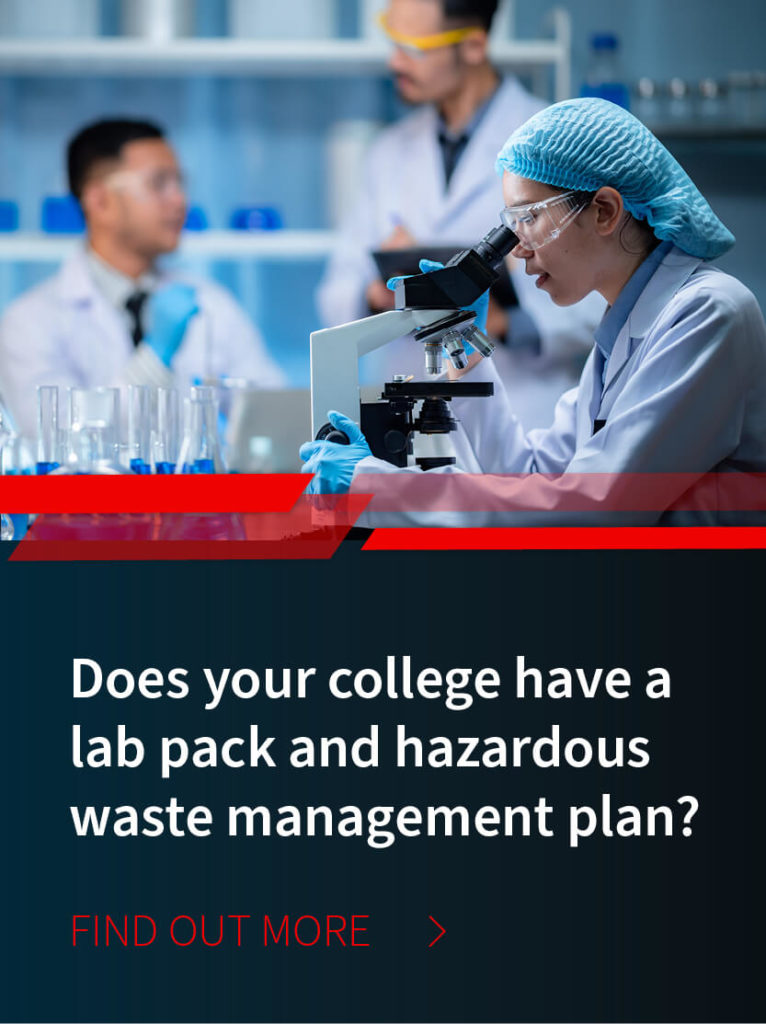
/ IN THIS BLOG
Proper management of hazardous waste in college academic labs is just as important as it is in a hospital or medical care environment. Protecting people and the environment is essential.
Many universities and colleges throughout the country - regardless of size - are also equipped with laboratories and medical facilities. As such, hazardous waste is often found on-site.
Does every member of your staff, as well as students, know how to manage hazardous waste in your lab? Dozens of chemicals are typically found in academic labs. Knowing how to identify them and properly store or dispose of them is essential to safety. Failure to do so can result in massive fines and punitive actions being taken against the educational institution.
Because management of these waste streams is so important in any scenario, we have provided some basic steps to take and crucial things to keep in mind regarding how to manage hazardous waste within your academic setting. From lab packs to segregation to transport off-site, know the laws not only of federal and state governmental agencies, but your college or university as well.
01 / Academic Lab Packs for Hazardous Materials
Waste management on a college or university campus often includes ‘lab packs’. A lab pack is simply a container – usually a box, canister, or drum – that contains expired or partially used chemicals that need to be transported off-site for disposal. A lab pack may also contain expired or mislabeled or contaminated chemicals.
Many teaching universities have on-site laboratories, and within those laboratories are found a variety of materials and chemicals—none of which can be disposed of safely in a ‘regular’ trash can. If your university or college has expired, un-used, damaged, or leftover chemicals that are just sitting on a shelf or that are left over from experiments involving chemicals, a lab pack is needed to ensure safe and legally compliant disposal. A number of important steps are required in this process.
02 / Identifying Hazardous Materials
Accurately identifying the materials you actually have within your lab setting is the first step toward safe and compliant hazardous waste management and disposal. Some chemicals found in college or university labs are not dangerous, but others are. Proper identification ensures the waste type is properly segregated from other waste streams, packaged and stored separately, and then sent to the proper facility to safely treat that particular waste.
The disposal processes for hazardous waste and non-hazardous waste are different, so it’s important to accurately identify such wastes. Remember that non-hazardous waste disposal entails different treatment methods than, say, bio-hazardous or hazardous materials, so it's important to properly determine what's in your lab, as well as other university departments.
Hazardous wastes are classified differently as well, and those differences also influence how they are disposed of. Review the Environmental Protection Agency’s treatment standards for hazardous wastes as well as disposal restrictions here.
Whatever combination of waste your lab has, it's imperative to know what everything is so that it can be safely stored, packaged, shipped, and treated without any adverse reactions such as ignitability, toxicity (and fumes), corrosively, or reactivity.
03 / Segregate and Pack according to Waste Type
Expired chemical disposal can be incredibly dangerous if not segregated and packaged correctly. Use of approved Department of Transportation (DOT) containers ensures that the specific type of hazardous waste goes into a container that is specially designed to handle that waste. For example, you wouldn’t put a corrosive waste into a metal container due to the potential of a chemical eating through the metal.
Proper packing techniques ensure that all flammable waste is kept separate from corrosive waste, which is then kept away from reactive waste. Accidentally combining two elements that react together poses extreme health and safety risks to anyone who comes into contact with or handles that waste.
Additional information regarding hazardous waste management processes for colleges and universities can be found under the Resource Conservation and Recovery Act (RCRA) and their guide ‘RCRA Orientation Manual’ – a must-read.
Pack all items safely and properly prior to transport. For example, all small vials should then go into larger containers that contain absorbent materials. This step adds safety measures in the event of a spill or any breakage. These containers should always be approved by the Department of Transportation.
Again, know the law. Refer to the EPA’s Hazardous Waste Transportation guidelines for identification, transportation, permitting requirements, and state-by-state authorizations. Don’t guess. Fines for non-compliant hazardous waste management infractions and improper disposal processes are huge. If in doubt, work with a knowledgeable and reputable hazardous waste management company.
04 / Choosing a Hazardous Waste Management Company
With safety and compliance stakes so high, your university will likely want to reach out to professionals who have the expertise and know-how to deal with hazardous waste from your labs and facilities. In particular, look for a company that can offer a full range of services when it comes to your lab department needs.
For example, an experienced company can send a qualified chemist to identify all the materials used in your lab and create an inventory in the beginning of the hazardous waste disposal process. Such expertise follows through to providing guidance on proper and compliant waste containers, to final transportation off campus and to an approved and certified hazardous waste disposal site.
A turn-key or hazardous waste lab pack service typically involves the following:
Identification of all materials within the lab
Creating an inventory of those materials
Provision of all DOT-certified containers
Timely, accurate, and necessary paperwork (profiles, shipping manifest, labels, placards, and so on).
All labor associated with the pack
All travel expenses associated with transport
If the lab pack is a particularly small job, a waste management company might simply send step-by-step instructions that the university must then follow to the letter. However, it is more than likely that the hazardous waste company will perform the actual duties of the pack themselves for one overall price.
Whatever your university's approach, it's imperative to have a sound hazardous waste management plan in place. It helps ensure the safety of the students and employees, and it protects the university itself against hefty fines and other negative consequences for non-compliance.
For more information about various aspects of university laboratory waste management, reach out to a representative of MCF Environmental Services, a hazardous waste management company with over three decades of experience. We are based in Atlanta and serve states throughout the country.
Robert Losurdo
President, COO








